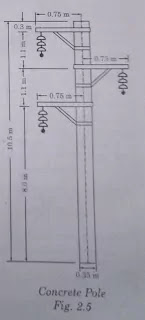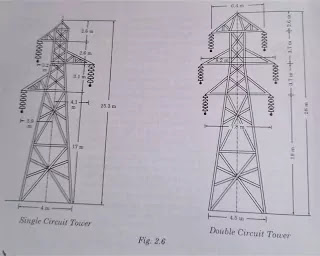Types of transmission towers
Types of transmission towers LINES SUPPORT:-
The operate of line support is clearly to support the conductors. Lines support should be capable of carrying the load thanks to insulators and conductors as well as the ice and wind masses on the conductors along side the wind load on the support itself. the road support square measure of varied kind as well as wood ,steel and reinforce concert poles, and steel towers either of the rigid or versatile kind.
A distribution is drawn between straight poles that dwell direct lines of transmission and commonly solely support the conductors and also the special poles which can carry some load thanks to conductor tension. The letter support is also angle towers, terminal towers, towers at play components, anchor towers, or tower for a few special purpose like for crossing the rivers. The dimension of those line supports square measure ruled by Inter-Services Intelligence laws. just in case of telegraph or railway line crossing special needs is to be met with.
THE MAIN needs OF THE LINES SUPPORTS ARE:-
1. High mechanical strength to face up to the burden of conductors and wind load etc.
2. lightweight in weight while not the loss of mechanical strength.
3. low {cost|low-cost} in cost
4. Low maintenance price.
5. Longer life.
6. smart trying.
7. simple accessibility for painting and erection of line conductors.
Types of transmission towers.The choice of line supports for a specific scenario depends upon the road span, cross-sectional space, line voltages, price and native conditions.
The design of the overhead lines support depends upon the actual fact weather the support is rigid or features a specific amount of flexibility within the direction of lines. wood poles and a few special sort of steel structure square measure of letter kind solely the thwartwise wind pressure occurring upon the conductors and upon the support itself is typically thought-about in their style.
The longitudinal pull of the conductors is generally balanced on either aspect of the support however within the event of breaking one or a lot of conductors on one aspect, there'll be AN Unbalance load which can be way in excess thwartwise wind pressure.
With versatile support this unbalance load is quickly absorbed by a rise AN sag in unmutilated span on account of bending of the on all sides of the destroyed span towards the adjacent span when 3 or four span the longitudinal pull becomes negligible. an explicit general rigidity within the direction is provides for apply by exploitation rigid ANchoring towers an interval of one.5 km or so. These anchoring towers in square measure designed to face up to the breaking of 1 wire in 3 on one aspect further as thwartwise load.
just in case of rigid supports like the lattice steel boards base stricture equal strength is typically provided in each the longitudinal and thwartwise direction and each tower is meant to with stand the unbalance load on account of breaking of 1 wire in 3 on identical aspect. additionally anchor towers usually provided within which the support is capable of withstanding the failure of 2 conductors out of 3 or perhaps of all conductors on one aspect.
WOODEN POLES:-
These supports square measure least expensive, simply on the market, offer insulating properties and thus, square measure extensively used for the distribution functions specially in rural electrification keeping the price low. Their use is typically restricted to low pressures (up to twenty two kV) and for brief spans (up to sixty meters). In districts having a plentiful provide of appropriate timber and wherever the price of transporting steel towers is high single and 'H' poles are used for overhead lines operational at voltages up to one hundred thirty potential unit and average span lengths of one hundred fifty meters. Sal or chir wood poles up to eleven meter length with minimum circumference of thirty eight cm at the highest and sixty six cm at all-time low square measure used.
These poles should be straight, sturdy with gradual taper and free from giant knots. The poles ought to be properly seasoned to stop speedy decay thanks to gap of cracks. to stop decay attributable to snow and rain, the wood poles square measure protected by atomic number 13, Zn or cement cap at the highest. The portion of the pole i.e. two meters from bottom that is buried within the ground should be treated with creosote oil or any preservative compound. The wood poles well inseminated with creosote oil or any preservative have life from twenty five to thirty years.
Wooden poles square measure terribly elastic and features using wood supports square measure usually designed throughout for the thwartwise load. Longitudinal strength at terminals and for anchor support is provided by means that of fellows. Double pole structures of A or H varieties square measure usually used for getting the next thwartwise strength than that would be economically provided by means that of single poles.
A pole that acts as a terminal or carries switchgear or a electrical device, or is employed at a sound purpose, is also of the 'H'-type.
The length of a wood pole depends upon clearance on top of the bottom surface and second, the quantity of cross-arms and alternative instrumentality to be connected. Normally, the length of wood pole is ten to twelve m.
The main drawbacks of wood supports are: tendency to rot below the bottom level, relatively smaller life, less mechanical strength and demand of periodical examination. wood poles square measure coated beneath IS: 876-1961.
transmission towers Steel Poles:-
The steel poles square measure of 3 varieties (I) cannular poles (ii) rail poles and (iii)
Had steel joists. The cannular poles square measure of spherical crosswise, the rail poles square measure of the form of track used for railways and rolled steel joists square measure of I crosswise.
Such poles possess larger mechanical strength and allow use of longer spans (50-80 m) however price is higher. Their life is longer than that of wood poles and life is multiplied by regular painting. These poles square measure set in concrete muffs at the inspiration so as to shield them from natural action. the typical lifetime of steel poles is over forty years.
RCC
Poles:-
Poles manufactured from strengthened cement concrete (RCC), typically known as the concrete poles, area unit extensively used for low voltage and high voltage distribution lines up to thirty three kilovolt. Their construction ought to change to the quality specification for RCC work, however in no case the size shall be less twenty five cm X twenty five cm at the lowest and thirteen cm x thirteen cm at the highest. RCC poles should change to IS: 785-1964. These poles area unit of 2 varieties in form. One kind is of sq. crosswise from bottom to prime. the opposite kind has rectangular bottom and sq. prime with rectangular holes in it to facilitate the rise of poles and cut back the load of poles.
These provide smart look, need no maintenance, have gotten insulating properties and resistance against natural process, terribly robust, have longer life and might be used for extended spans (80-200 m). Such poles area unit appropriate|best suited|most fitted} for soggy things wherever alternative varieties won't be in any respect suitable, as because of standing water wood poles can decay terribly chop-chop, and steel construction are having deposit of rust.
Since these poles area unit terribly large and serious, therefore, transportation value is serious and want care in handling and erection. they will be factory-made at web site itself to avoid serious value of transportation. However, prestressed concrete poles, known as the PCC poles, area unit less large and lighter than RCC poles PCC poles area unit extensively used on eleven kilovolt and it lines. PCC poles should change to IS: 1678. 1960.
transmission towers Lattice Steel Towers:-
Though there's no onerous and quick rule however wood poles area unit typically used for distribution functions in geographic region, the steel cannular poles and concrete poles area unit typically used for distribution in {urban area unita|populated area|geographical area|geographic area|geographical region|geographic region} to allow smart look and steel rails or narrow-base; lattice-steel towers are used for transmission at eleven kilovolt and thirty three kilovolt and broad. Base lattice-steel towers area unit used for transmission functions at sixty six kilovolt and on top of.
The broad base, lattice-steel towers area unit automatically stronger and have gotten longer life. because of their sturdy construction long spans (300 m or above) is used and area unit a lot of helpful for crossing fields, valleys, railway lines, river etc. even if these area unit 2 to fourfold costlier than wood poles, however for tall supports and longer spans these prove additional economical.
Furthermore their dependability is of a high degree. The substantial construction of the towers renders them capable of withstanding the foremost severe weather conditions and immune from destruction by forest fires. the danger of service interruptions, because of broken or perforate insulators, is significantly reduced thanks to use of huge spans. Lightning troubles are decreased as every tower could be a conductor, whereas on wood pole lines shattered poles and destroyed line sections aren't sporadic. Steel towers area unit fictional from painted or galvanized angle sections which may be
Transported severally and therefore the erection done on web site. At a moderate value these is designed for double circuit giving an extra insurance against separation of provide. just in case of breakdown to 1 circuit it's attainable to hold out repairs whereas maintaining the continuity of provide on the opposite circuit. the peak of the tower depends on the road voltage and length of span. The legs of the towers area unit set in special concrete foundations. The forces to be taken into consideration within the style of a tower area unit vertical various conductors, insulators, fittings and tower itself, wind pressure on conductors and wind pressure on tower itself.
Steel towers is loosely classified as tangent towers and deviation towers. Tangent towers is used for straight runs of the road and up to 2° line deviation from the straight runs. the bottom of such a steel tower is also sq. or rectangular. Insulators used with such towers area unit suspension varieties.
For deviations prodigious 2°, special angle towers, generally known as the deviation towers, are used. Such towers have broader base and stronger members as {they area unit|they're} to face up to the resultant force because of amendment in direction additionally to the forces to that the tangent towers are subjected. Insulators used with such towers area unit of strain kind. the price of deviation tower is relatively larger than that of a tangent tower as a result of it's designed to face up to serious loading as compared to straightforward or tangent tower.
For protection against corrosion the steel towers area unit sporadically painted or galvanized. The lifetime of steel towers is created nearly indefinitely giant by an inexpensive quantity of attention to their maintenance.
The advantages and drawbacks of single circuit and double circuit styles area unit given below in tabular type
🙏🙏THANKING YOU for read full article Types of transmission towers











No comments:
if you have any doubts,please let me know